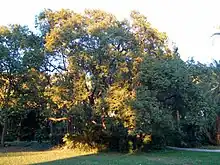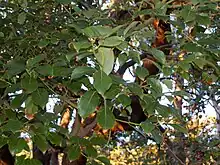| Camphora glandulifera | |
|---|---|
 | |
| Scientific classification | |
| Kingdom: | Plantae |
| Clade: | Tracheophytes |
| Clade: | Angiosperms |
| Clade: | Magnoliids |
| Order: | Laurales |
| Family: | Lauraceae |
| Genus: | Camphora |
| Species: | C. glandulifera |
| Binomial name | |
| Camphora glandulifera (Wall.) Nees | |
| Synonyms | |
| |
Camphora glandulifera, common name false camphor tree or Nepal camphor tree, is a tree in the genus Cinnamomum of the family Lauraceae.
Description

Cinnamomum glanduliferum is an evergreen tree reaching a height around 5–20 m (16–66 ft). Leaves are shiny, dark green, alternate, petiolated, elliptic to ovate or lanceolate, 6–15 cm (2.4–5.9 in) long and 4–6.5 cm (1.6–2.6 in) wide. Flowers are yellowish and small, about 3 mm (0.12 in) wide. Fruits are black, globose, up to 1 cm (0.39 in) in diameter. Flowering period extends from March through May and the fruits ripen from July to September.[2] The leaves have a characteristic smell and contain camphor and essential oils.
Distribution
This plant is native to China, Bhutan, India, Malaysia, Myanmar, and Nepal.[2]
Habitat
In China, C. glanduliferum grows in broad-leaved forests of mountainous regions, at an elevation around 1,500–2,500 m (4,900–8,200 ft) above sea level, sometimes higher.[2]
References
- ↑ Liu, B.; Liu, H.; Botanic Gardens Conservation International (BGCI) & IUCN SSC Global Tree Specialist Group (2019). "Cinnamomum glanduliferum". IUCN Red List of Threatened Species. 2019: e.T147648804A147648806. Retrieved 25 June 2022.
- 1 2 3 Xi-wen Li, Jie Li & Henk van der Werff. "Cinnamomum glanduliferum". Flora of China. Missouri Botanical Garden, St. Louis, MO & Harvard University Herbaria, Cambridge, MA. Retrieved 28 March 2013.
Further reading
- Baruah, A.; Nath, S. C. (2006). "Leaf Essential Oils of Cinnamomum glanduliferum (Wall) Meissn and Cinnamomum glaucescens (Nees) Meissn". Journal of Essential Oil Research. 18 (2): 200. doi:10.1080/10412905.2006.9699065. S2CID 98217027.
External links
